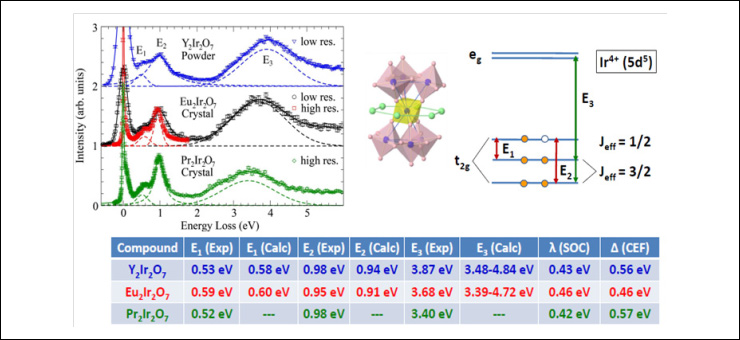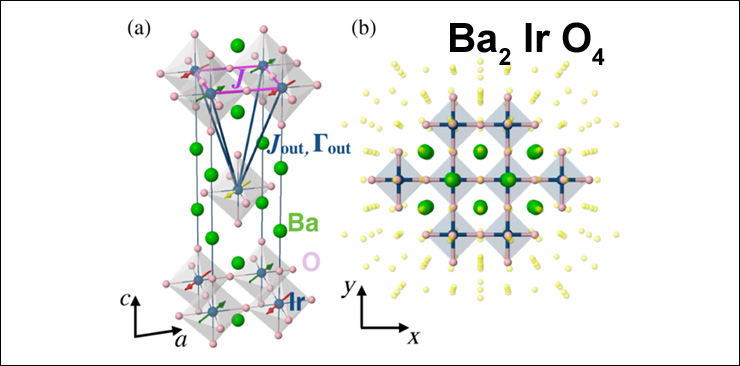New approach to the study of transition metal oxides
Publications, 21 August 2020
The series of studies “Ab initio quantum-chemical approach to the study of the crystal field and quantum magnetism in transition metal oxides” carried out by the international team of authors comprising of L. A. Siurakshina (LIT JINR), V. Yu. Yushankhai (BLTP JINR), P. Fulde (MPI PKS, Dresden, Germany), L. Hozoi and J. van den Brink (IFW, Dresden, Germany) was awarded the second JINR Prize for 2019 in the section of theoretical research.
Transition metal oxides declared themselves more than thirty years ago with the discovery of high-temperature superconductivity in copper oxides and their study has now become a distinct field of condensed matter physics. Hundreds of new transition metals oxides have been synthesized, including the iron group and heavier elements of the palladium group, with different crystal structures and a high potential for practical applications, for example, as microelectronic devices of a new generation. Nowadays experimental studies of this class of materials are carried out in many scientific centers, including FLNP JINR. Transition metal oxides with their unusual properties also serve as the basis for the construction and implementation of new theoretical models and methods with the aim of studying, first of all, quantum magnetism and many-particle effects of strong electron correlations, such as unusual orbital and spin orderings in crystal structures, the formation of new quantum correlated phases in which topology plays an important role. Some of the results of our research in this field are presented in a series of competition papers.
The uniqueness of the approach to solving the posed problems lies in the application and development of the method of cluster quantum chemical calculations. In its initial formulation, the method was based on the use of specialized computer codes introduced to quantum chemistry as a theoretical tool aimed at the quantitative description of interatomic chemical bonds in individual molecules. Since 2011, in the works of the authors, this method has been generalized and developed in order to quantitatively describe the local electronic structure and magnetic characteristics of clusters, i.e. fragments of a regular crystal structure with lattice parameters taken from independent experimental measurements. The approach developed by us avoids the use of approximations inherent in the standard density functional theory and provides unique information about the electronic structure and magnetic interactions that cannot be achieved by other theoretical means. By now, due to the efforts of the authors, the method of cluster quantum-chemical calculations has become a working tool for the quantum theory of condensed matter.
Experts note the following most significant achievements of the authors:
As is known, in the crystalline phase of a substance, the energy spectrum and wave functions of valence electron orbitals are determined by internal electric fields together with the effects of covalent chemical bonds, which is collectively called the effects of the crystal field. Their theoretical description, based on the application of the group point symmetry formalism, traditionally has only a qualitative character. The achievements of the authors include the development and implementation of a quantitative method for first-principle quantum-chemical calculations of crystal fields for magnetic ions of transition elements in oxides with any type of crystal lattice (references [1] – [3] and [5], [6] and [8] in the worklist).
It is well known that the selection rules for optical dipole transitions prohibit using the traditional technique of optical experiments to measure the level structure of electron orbitals of the same spatial parity in a crystal field. On the other hand, the possibility of carrying out such measurements with modern synchrotron X-ray sources is being actively discussed. In this regard, the authors’ achievement is the detailed theoretical description of electronic transitions between levels of the crystal field in the processes of inelastic X-ray scattering [3] presented in the works of the series and the successful application of this theory, including quantum-chemical calculations, for the quantitative explanation of the experimental spectrum of inelastic X-ray scattering by crystal fields one of the iridium oxides.
The results of the experiment carried out at the synchrotron source of the Argonne National Laboratory, USA, and their theoretical interpretation (Fig. 1) are reported in the joint publication [4].
 Fig.1. Lattice cluster of the iridium oxides family ReIr2O7, crystal field diagram for iridium ion and experimental spectrum of inelastic scattering of X-ray synchrotron radiation. [4]
Fig.1. Lattice cluster of the iridium oxides family ReIr2O7, crystal field diagram for iridium ion and experimental spectrum of inelastic scattering of X-ray synchrotron radiation. [4]In the second part of the cycle ([5], [7], [9] and [10]), the method of quantum-chemical calculations was developed further and extended in order to calculate the local electronic structure – the energy spectrum and the shape of the wave functions of low-energy electronic states for a pair of exchange-interacting spins of transition-metal atoms in an oxide composition. At the next stage, for exchange-interacting atoms, a procedure is proposed for choosing an effective spin model, the spectrum of which is in one-to-one correspondence with the results of quantum-chemical calculations for the selected oxide composition. Thus, the method first developed by the authors provides a regular basis for constructing and substantiating quantum models of magnetism, which have been successfully applied to a wide family of transition metal oxides.
 Fig.2. (a) Layered crystal structure of iridium oxide Ba2IrO4. The paths of spin interactions for iridium ions in the plane and between the layers are shown. (b) Schematic of a cluster used for calculating spin interactions in a layer. It consists of a central [Ir2O11]fragment — two common IrO6 octahedra and six other adjacent octahedra. [6]
Fig.2. (a) Layered crystal structure of iridium oxide Ba2IrO4. The paths of spin interactions for iridium ions in the plane and between the layers are shown. (b) Schematic of a cluster used for calculating spin interactions in a layer. It consists of a central [Ir2O11]fragment — two common IrO6 octahedra and six other adjacent octahedra. [6]The power of the method described in the previous paragraph the authors have demonstrated in oxides of a heavy transition element – iridium. Spin interactions arrange a certain order between the magnetic moments of iridium ions at the lattice sites, an example of which is shown in Fig. 2. In addition, a comparatively large atomic number (77) of iridium requires including relativistic corrections to these interactions in the calculation. The numerical solution of such a problem, including a quantitative assessment of exchange interactions of different types for a pair of magnetic iridium ions at the nodes of the crystal lattice, is recognized as a significant achievement of the authors.
The application of the quantum chemistry methods, based on the use of the MOLPRO software package, demonstrated by the international team of authors to solving problems in the physics of condensed matter is innovative and expands the toolkit for theoretical and numerical analysis of the effects of crystal field and quantum magnetism not only for transition metal oxides but also for a wider range of new materials.
List of papers:
- Ab Initio determination of Cu 3d orbital energies in layered copper oxides, L. Hozoi, L. Siurakshina, P. Fulde, J. van den Brink, Sci. Rep., 1, 65, 1-4, 2011.
- Ab initio calculation of d-d excitations in quasi-one-dimensional Cu d9 correlated materials, Hsiao-Yu Huang, N. A. Bogdanov, L.Siurakshina, P. Fulde, J. van den Brink, and L. Hozoi, Phys. Rev. B 84, 235125(1-8), 2011.
- Analysis of Crystal-Field Multiplets of V3+ Ion in Perovskite Oxides for Resonant Inelastic X-Ray Scattering Spectroscopy, V. Yushankhai, L. Siurakshina, Int. J. Mod. Phys. B 27, 31, 1350185(1-15), 2013.
- Longer-range lattice anisotropy strongly competing with spin-orbit interactions in pyrochlore iridates, L. Hozoi, H. Gretarsson, J. P. Clancy, B.-G. Jeon, B. Lee, K. H. Kim, V. Yushankhai, P. Fulde, D. Casa, T. Gog, J. Kim, A. H. Said, M. H. Upton, Y.-J. Kim, and J. van den Brink, Phys. Rev. B 89, 115111 (1-6), 2014.
- Electronic Structure of Low-Dimensional 4d5 Oxides: Interplay of Ligand Distortions, Overall Lattice Anisotropy, and Spin-Orbit Interactions, V. M. Katukuri, K.Roszeitis, V.Yushankhai, A.Mitrushchenkov, H.Stoll, M. van Veenendaal, P.Fulde, J. van den Brink, and L. Hozoi, Inorg. Chem., 53, 4833-39, 2014.
- Mechanism of Basal-Plane Antiferromagnetism in the Spin-Orbit Driven Iridate Ba2IrO4 V.M. Katukuri, V. Yushankhai, L. Siurakshina, J. van den Brink, L. Hozoi, and I. Rousochatzakis, Phys. Rev. X4, 021051 (1-10), 2014.
- Kitaev interactions between j = 1/2 moments in honeycomb Na2IrO3 are large and ferromagnetic: insights from ab initio quantum chemistry calculations, V.Katukuri, S. Nishimoto, V. Yushankhai, A. Stoyanova, H. Kandpal, S. Choi, R. Coldea, I. Rousochatzakis, L. Hozoi, and J. van den Brink, New J. Phys., 16, 013056 (12 pages), 2014.
- Orbital reconstruction in nonpolar tetravalent transition-metal oxide layers, N. Bogdanov, V. Katukuri, J. Romhanyi, V. Yushankhai, V. Kataev, B. Buchner, J. van den Brink, L. Hozoi, NATURE Comm., 6, 7306 (1-9), 2015.
- Strongly frustrated triangular spin lattice emerging from triplet dimer formation in honeycomb Li2IrO3, S. Nishimoto, V. Katukuri, V. Yushankhai, H. Stoll, U. Roessler, L. Hozoi, I. Rousochatzakis, J. van den Brink, NATURE Comm., 7, 10273 (1-7), 2016.
- Superexchange interactions between spin-orbit-coupled j=1/2 ions in oxides with face-sharing ligand octahedra, L. Xu, R. Yadav, V. Yushankhai, L. Siurakshina, J. van den Brink, and L. Hozoi, Phys. Rev. B99, 115119 (1-11), 2019.